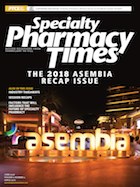Publication
Article
Specialty Pharmacy Times
Challenges in Treating Idiopathic Pulmonary Fibrosis
Idiopathic pulmonary fibrosis (IPF) remains difficult to diagnose and manage because of its unknown etiology, varied clinical course, associated comorbidities, and nonspecific respiratory symptoms.
Idiopathic pulmonary fibrosis (IPF) remains difficult to diagnose and manage because of its unknown etiology, varied clinical course, associated comorbidities, and nonspecific respiratory symptoms, according to a continuing education symposium presented at the Asembia Specialty Pharmacy Summit 2018. Two agents, nintedanib and pirfenidone, were approved by the FDA approved for the treatment of IPF in 2014 and, along with antacids, are the only agents recommended for use in the American Thoracic Society’s updated 2015 IPF clinical practice guidelines. However, use of these agents is expected to significantly increase the cost of care, considering each treatment regimen exceeds $90,000 annually.
This symposium provided a review of the guidelines and use of these agents in clinical practice, along with strategies for improving adherence and minimizing costs. The presentation started with a review of IPF diagnosis (including diagnostic criteria, process, and multidisciplinary team) and comorbidities such as gastroesophageal disease (GERD) and obstructive sleep apnea (OSA). Treating GERD and OSA in patients with IPF is associated with improved survival.
The symposium then reviewed recommendations for course of therapy, from treatment of comorbidities and hypoxia to referral to an IPF center for specialized care. The main goals of IPF treatment are slowing progression, improving symptoms and quality of life, and managing comorbid conditions. The decision to begin nintedanib or pirfenidone should be based on provider and patient assessment of treatment goals, along with financial considerations and the significant adverse drug reactions associated with these agents.
The most common adverse events during clinical trials were nausea, rash, upper respiratory infection, fatigue, dyspepsia, and anorexia in patients receiving pirfenidone and diarrhea, nausea, nasopharyngitis, cough, and vomiting in patients receiving nintedanib. The symposium then provided detailed strategies for the specialty pharmacist in addressing patients’ concerns regarding adverse events and costs of these agents to ultimately get the patient on a drug and keep them on it. To address that factor, the presentation reviewed private and manufacturer foundations to help with expense, noting a rule of thumb of greater than $150,000 gross household income for financial assistance, although even high-income households may be considered under certain circumstances.
Once the drug is started, the specialty pharmacist can help keep the patient on it by addressing fears of adverse events, ensuring the patient knows how to use antidiarrheal therapies, advising the patient to take the medication before a large snack or meal, and encouraging the patient to seek help when any adverse events do occur. The presentation concluded with information on how to manage adverse events once they do occur, such as slowing titration or reducing dosage, with ultimate considerations of a drug vacation or a switch to another agent.







